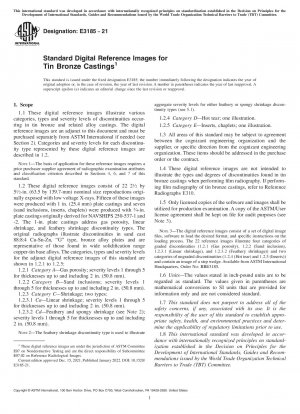ASTM E3185-21
Standard Digital Reference Images for Tin Bronze Castings
- Standard No.
- ASTM E3185-21
- Release Date
- 2021
- Published By
- American Society for Testing and Materials (ASTM)
- Latest
- ASTM E3185-21
- Scope
- 1.1 These digital reference images illustrate various categories, types and severity levels of discontinuities occurring in tin bronze and related alloy castings. The digital reference images are an adjunct to this document and must be purchased separately from ASTM International if needed (see Section 2). Categories and severity levels for each discontinuity type represented by these digital reference images are described in 1.2. NOTE 1—The basis of application for these reference images requires a prior purchaser supplier agreement of radiographic examination attributes and classification criterion described in Sections 4, 6, and 7 of this standard. 1.2 These digital reference images consist of 22 21⁄2 by 51⁄2-in. (63.5 by 139.7-mm) nominal size reproductions originally exposed with low voltage X-rays. Fifteen of these images were produced with 1 in. (25.4 mm) plate castings and seven (sand inclusions, inserts, chaplets) were produced with 3⁄4-in. plate castings originally derived for NAVSHIPS 250-537-1 and -2. The 1-in. plate castings address gas porosity, linear shrinkage, and feathery shrinkage discontinuity types. The original radiographs illustrate discontinuities in sand cast 88:8:4 Cu-Sn-Zn, “G” type, bronze alloy plates and are representative of those found in wide solidification range copper-tin base alloys. The categories, types and severity levels for the adjunct digital reference images of this standard are shown in 1.2.1 to 1.2.5: 1.2.1 Category A—Gas porosity; severity levels 1 through 5 for thicknesses up to and including 2 in. (50.8 mm). 1.2.2 Category B—Sand inclusions; severity levels 1 through 5 for thicknesses up to and including 2 in. (50.8 mm). 1.2.3 Category C—Shrinkage; two types: 1.2.3.1 Ca—Linear shrinkage; severity levels 1 through 5 for thicknesses up to and including 2 in. (50.8 mm). 1.2.3.2 Cd—Feathery and spongy shrinkage (see Note 2); severity levels 1 through 5 for thicknesses up to and including 2 in. (50.8 mm). NOTE 2—The feathery shrinkage discontinuity type is used to illustrate aggregate severity levels for either feathery or spongy shrinkage discontinuity types (see 5.1). 1.2.4 Category D—Hot tear; one illustration. 1.2.5 Category E—Inserts, chaplets; one illustration. 1.3 All areas of this standard may be subject to agreement between the cognizant engineering organization and the supplier, or specific direction from the cognizant engineering organization. These items should be addressed in the purchase order or the contract. 1.4 These digital reference images are not intended to illustrate the types and degrees of discontinuities found in tin bronze castings when performing film radiography. If performing film radiography of tin bronze castings, refer to Reference Radiographs E310. 1.5 Only licensed copies of the software and images shall be utilized for production examination. A copy of the ASTM/User license agreement shall be kept on file for audit purposes (see Note 3). NOTE 3—The digital reference images consist of a set of digital image files, software to load the desired format, and specific instructions on the loading process. The 22 reference images illustrate four categories of graded discontinuities (1.2.1 (Gas porosity), 1.2.2 (Sand inclusion), 1.2.3.1 (Linear shrinkage), and 1.2.3.2 (Feathery shrinkage)) and two categories of ungraded discontinuities (1.2.4 (Hot tear) and 1.2.5 (Inserts)) and contain an image of a step wedge. Available from ASTM International Headquarters, Order No: RRE3185. 1.6 Units—The values stated in inch-pound units are to be regarded as standard. The values given in parentheses are mathematical conversions to SI units that are provided for information only and are not considered standard. 1.7 This standard does not purport to address all of the safety concerns, if any, associated with its use. It is the responsibility of the user of this standard to establish appropriate safety, health, and environmental practices and determine the applicability of regulatory limitations prior to use. 1.8 This international standard was developed in accordance with internationally recognized principles on standardization established in the Decision on Principles for the Development of International Standards, Guides and Recommendations issued by the World Trade Organization Technical Barriers to Trade (TBT) Committee. 1 These digital reference images are under the jurisdiction of ASTM Committee E07 on Nondestructive Testing and are the direct responsibility of Subcommittee E07.02 on Reference Radiological Images. Current edition approved Dec. 15, 2021. Published January 2022. DOI: 10.1520/ E3185-21. Copyright © ASTM International, 100 Barr Harbor Drive, PO Box C700, West Conshohocken, PA 19428-2959. United States This international standard was developed in accordance with internationally recognized principles on standardization established in the Decision on Principles for the Development of International Standards, Guides and Recommendations issued by the World Trade Organization Technical Barriers to Trade (TBT) Committee. 1 2. Referenced Documents
ASTM E3185-21 Referenced Document
- ASTM B271 Standard Specification for Copper-Base Alloy Centrifugal Castings
- ASTM B584 Standard Specification for Copper Alloy Sand Castings for General Applications*, 2022-10-01 Update
- ASTM B61 Standard Specification for Steam or Valve Bronze Castings
- ASTM B62 Standard Specification for Composition Bronze or Ounce Metal Castings
- ASTM E1316 Standard Terminology for Nondestructive Examinations*, 2024-02-01 Update
- ASTM E2002 Standard Practice for Determining Total Image Unsharpness in Radiology
- ASTM E310 Standard Reference Radiographs for Tin Bronze Castings
ASTM E3185-21 history
- 2021 ASTM E3185-21 Standard Digital Reference Images for Tin Bronze Castings
